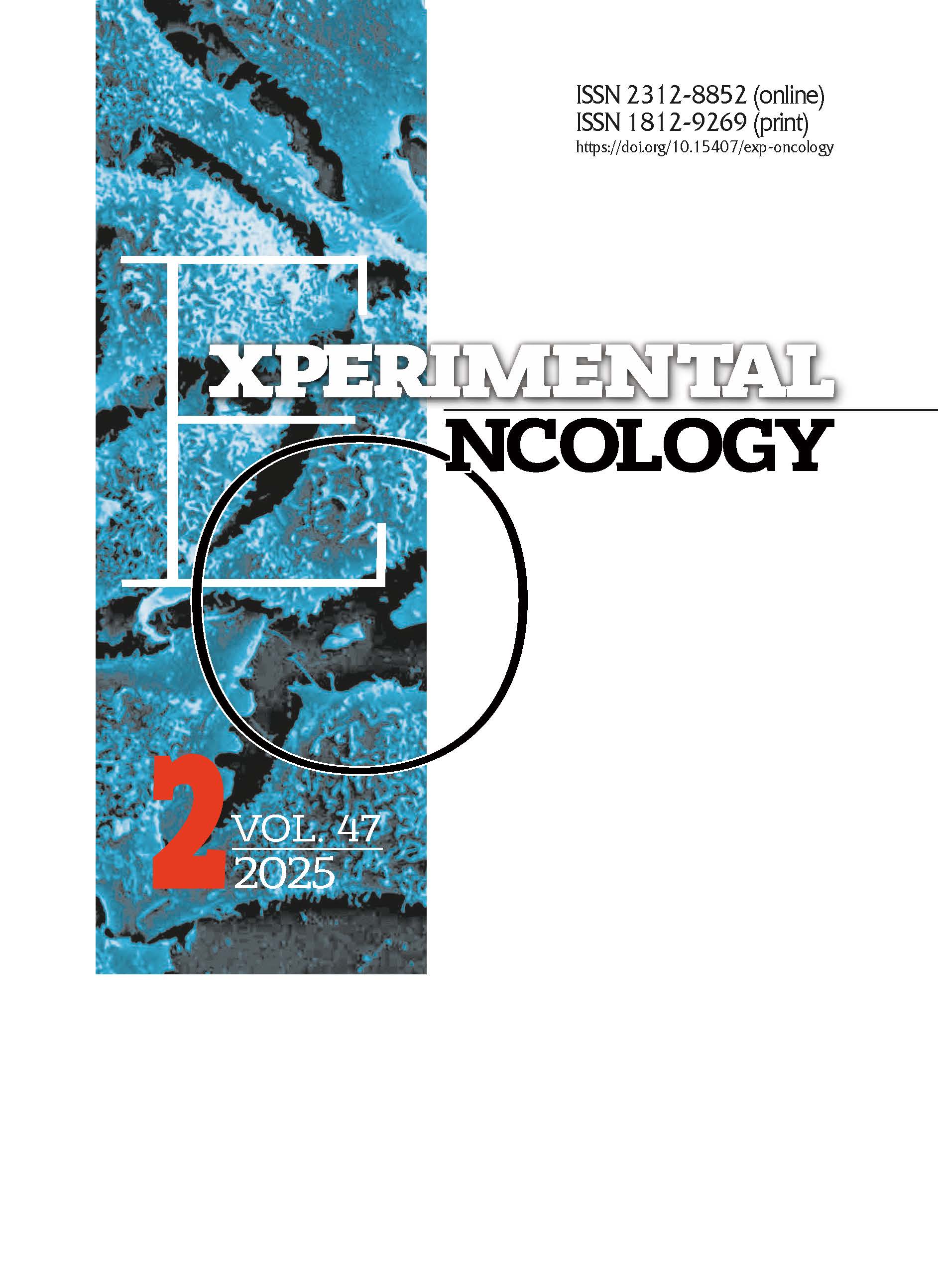INTERPLAY OF EPIGENETIC REGULATION OF KI-67 AND P53 BY MIR-21 AND MIR-34A IN CERVICAL INTRAEPITHELIAL NEOPLASIA
DOI:
https://doi.org/10.15407/exp-oncology.2025.02.223Keywords:
miRNA, Ki-67, p53, cervical intraepithelial neoplasia, HPVAbstract
Background. Cervical cancer (CC), primarily linked to persistent HPV infection, arises from complex genetic and epigenetic alterations. The early detection of cervical intraepithelial neoplasia (CIN) allows for CC prevention. Recent data highlights the importance of epigenetic biomarkers, including non-coding RNAs such as miR-21 and miR-34a. Our aim was to investigate the interplay between Ki-67 and p53 expression and their epigenetic regulation by miR-21 and miR-34a to better predict the course of CIN. Materials and Methods. Tumor biopsies from 50 patients with CIN 1–3/HSIL were analyzed. We performed immunohistochemical analysis of Ki-67 and p53 expression and qRT-PCR for the analysis of miRNA expression. Results. The average miR-21 and miR-34a levels were 5.8 ± 2.8 and 1.42 ± 0.85 (a.u.), respectively, while Ki-67 and p53 averaged 136.9 ± 79.9 and 93.15 ± 49.5 H-score points. Positive correlations were found between miR-21 and Ki-67 (r = 0.76) and miR-34a and p53 expressions (r = 0.65). Tumors with low Ki-67 showed 2.48-fold lower miR-21 levels, and low p53 tumors showed 4.2-fold lower miR-34a levels. While no correlation with age or menstrual status was found, miR-21 (r = 0.78), Ki-67 (r = 0.68), and miR-34a (r = –0.59) correlated with CIN grading (p < 0.05). The miR-21 and Ki-67 levels increased in CIN 2 and CIN 3 compared to CIN 1 in both HPV-positive and HPV-negative samples. The miR-34a levels were the lowest in CIN 3 HPV-negative samples and significantly decreased with CIN progression in HPV-positive samples. The p53 levels were significantly higher in CIN 3 cases of both the HPV-positive and HPV-negative groups. Conclusion. Our study demonstrates that the miR‑21, miR-34a, Ki-67, and p53 expression levels are significantly correlated with each other and are distinctly associated with the progression of CIN grades and HPV status, highlighting their potential as crucial CC biomarkers.
References
Singh D, Vignat J, Lorenzoni V, et al. Global estimates of incidence and mortality of cervical cancer in 2020: a base- line analysis of the WHO Global Cervical Cancer Elimination Initiative. Lancet Glob Health. 2023;11(2):e197-e206. https://doi.org/10.1016/S2214-109X(22)00501-0
Kakaliashvili-Dzagnidze S., Khardzeishvili O, Tabagari S. Diagnostic Accuracy of p16INK4a/Ki‐67 dual immunos- taining for detection of high‐grade cervical intraepithelial neoplasia in women involved in cervical cancer screen- ing in Georgia. Analyt Cellul Pathol. 2023(1):7988323. https://doi.org/10.1155/2023/7988323
Fang J, Zhang H, Jin S. Epigenetics and cervical cancer: from pathogenesis to therapy. Tumor Biol. 2014;35:5083- 5093. https://doi.org/10.1007/s13277-014-1737-z
Zhu Y, Han Y, Tian T, et al. MiR-21-5p, miR-34a, and human telomerase RNA component as surrogate markers for cervical cancer progression. Pathol Res Pract. 2018;214(3):374-379. https://doi.org/10.1016/j.prp.2018.01.001
Crook T, Wrede D, Tidy JA, et al. Clonal p53 mutation in primary cervical cancer: association with human-papil- lomavirus-negative tumours. Lancet. 1992;339(8801): 1070-1073. https://doi.org/10.1016/0140-6736(92)90662-M
Zhao X, Sun W, Ren Y, Lu Z. Therapeutic potential of p53 reactivation in cervical cancer. Crit Rev Oncol Hematol.
;157:103182. https://doi.org/10.1016/j.critrevonc.2020.103182
Asker HA, Khorshed EN, Ahmed MR, et al. Prognostic values of microRNA-21 and Ki-67 in diffuse large B-cell lymphoma patients: Egyptian experience. Clin Lab. 2021;67(7):1697. https://doi.org/10.7754/Clin.Lab.2021.201132
Kawami M, Takenaka S, Akai M, et al. Characterization of miR-34a-induced epithelial–mesenchymal transi- tion in non-small lung cancer cells focusing on p53. Biomolecules. 2021;11(12):1853. https://doi.org/10.3390/ biom11121853
Mushii O, Pavlova A, Bazas V, et al. Mast cells as a factor in regulation of breast cancer stromal component associated with breast cancer aggressiveness. Exp Oncol. 2024;46(4):311-323. https://doi.org/10.15407/exp-oncology.2024.04.311
Svintsitska A, Lygyrda N, Svintsitskyi V, et al. Expression of miRNAs in the presence of HPV infection in cervical dys- plasia samples: A pilot study. Exp Oncol. 2024;46(4):387-392. https://doi.org/10.15407/exp-oncology.2024.04.387
Parvizi M, Vaezi M, Jeddi F, et al. The role and diagnostic value of deregulated miRNAs in cervical cancer. Discov Onc. 2025;16:922. https://doi.org/10.1007/s12672-025-02744-4
Choi PW, Liu TL, Wong CW, et al. The dysregulation of MicroRNAs in the development of cervical pre-cancer—an update. Int J Mol Sci. 2022;23(13):7126. https://doi.org/10.3390/ijms23137126
Mitildzans A, Arechvo A, Rezeberga D, Isajevs S. Expression of p63, p53 and Ki-67 in patients with cervical in- traepithelial neoplasia. Turk Patoloji Derg. 2017;33(1):9-16. https://doi.org/10.5146/tjpath.2016.01373
Funk L, C, Wan J, Ryan S, D, et al. p53 is not required for high CIN to induce tumor suppression. Mol Cancer Res.
;19(1):112-123. https://doi.org/10.1158/1541-7786.MCR-20-0488
Raver-Shapira N, Marciano E, Meiri E, et al. Transcriptional activation of miR-34a contributes to p53-mediated apoptosis. Mol Cell. 2007;26:731-743. https://doi.org/10.1016/j.molcel.2007.05.017
Ribeiro J, Sousa H. MicroRNAs as biomarkers of cervical cancer development: a literature review on miR-125b and miR-34a. Mol Biol Rep. 2014;41:1525-31. https://doi.org/10.1007/s11033-013-2998-0
Burtyn O, Borikun T, Rossylna O, et al. Clinical significance of salivary mir-21,-155, and-375 in patients with squamous cell carcinoma of oral cavity. Exp Oncol. 2024;46(2):139-145. https://doi.org/10.15407/exp-oncolo- gy.2024.02.139
Yao T, Lin Z. MiR-21 is involved in cervical squamous cell tumorigenesis and regulates CCL20. Biochim Biophys Acta. 2012;1822(2):248-260. https://doi.org/10.1016/j.bbadis.2011.09.018
Liu M, Wang W, Chen H, et al. miR‐9, miR‐21, miR‐27b, and miR‐34a expression in HPV16/58/52‐infected cervical cancer. BioMed Res Int. 2020;1:2474235. https://doi.org/10.1155/2020/2474235
Bumrungthai S, Ekalaksananan T, Evans MF et al. Up-regulation of miR-21 is associated with cervicitis and human papillomavirus infection in cervical tissues. PloS One. 2015;10(5):e0127109. https://doi.org/10.1371/journal. pone.0127109
Chen J, Zhao KN. HPV-p53-miR-34a axis in HPV-associated cancers. Ann Transl Med. 2015;3(21):331. https://doi. org/10.3978/j.issn.2305-5839.2015.09.3.
Gocze K, Gombos K, Kovacs K, et al. MicroRNA expressions in HPV-induced cervical dysplasia and cancer. Anti- cancer Res. 2015;35(1):523-530.
Mimica M, Tomić S, Kardum G, et al. Ki-67 quantitative evaluation as a marker of cervical intraepithelial neo- plasia and human papillomavirus infection. Int J Gynecol Cancer. 2010;20(1):116-119. https://doi.org/10.1111/ IGC.0b013e3181bc8da7
Xing Z, Danhua S, Xiaobo Z. Diagnostic validity of p16, E-cadherin, cyclin D1, p53, and HPV E6/E7 mRNA in CIN 3-like squamous cell carcinoma of the cervix. Front Oncol. 2024;14:1354838. https://doi.org/10.3389/ fonc.2024.1354838
Silva D, C, Goncalves A, K, Cobucci R, N, et al. Immunohistochemical expression of p16, Ki-67 and p53 in cervi- cal lesions–A systematic review. Pathol Res Pract. 2017;213(7):723-729. https://doi.org/10.1016/j.prp.2017.03.003
Downloads
Published
How to Cite
Issue
Section
License
Copyright (c) 2025 Experimental Oncology

This work is licensed under a Creative Commons Attribution-NonCommercial-NoDerivatives 4.0 International License.



